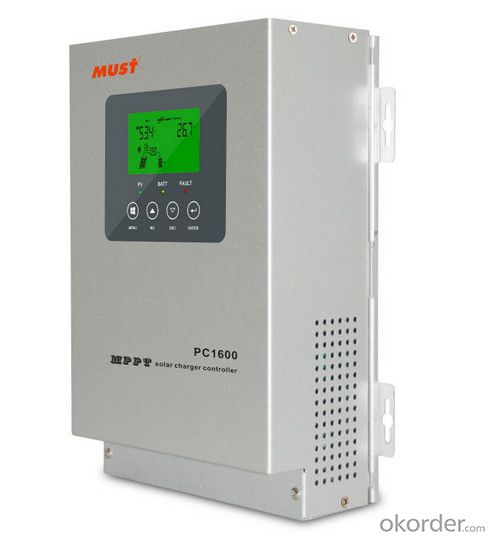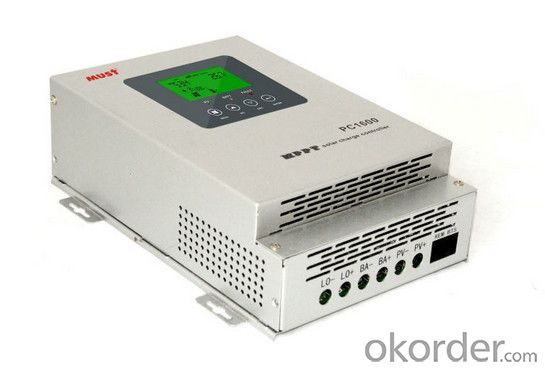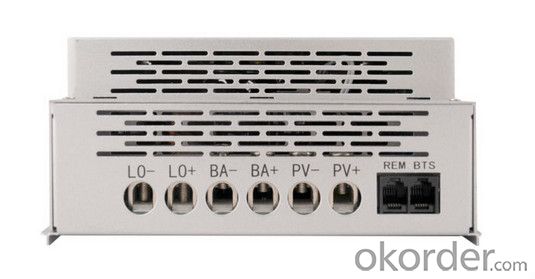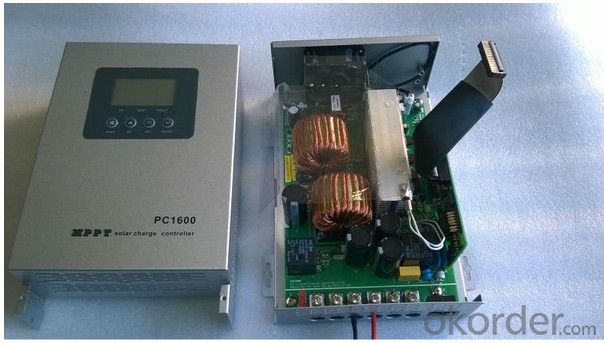MPPT Solar Charger Controller2015 Best Selling New Design PC1600F Series
- Loading Port:
- China main port
- Payment Terms:
- TT OR LC
- Min Order Qty:
- 1 pc
- Supply Capability:
- 1000 pc/month
OKorder Service Pledge
OKorder Financial Service
You Might Also Like
The Features of PC1600F MPPT Solar Charger Controller :
·45A/60A MPPT solar charge controller
·24V/48V auto work
·PV Output :70v-145v
·Several seconds tracking speed
·High Tracking efficiency of 99%
·Multiphase synchronous rectification technology
·Peak conversion efficiency of 98%
·DSP processors architecture ensures high speed and performance
·Multifunction LCD displays system data and status
·Four stages charging optimizes battery performance
The Specification of PC1600F MPPT Solar Charger Controller :
| odel | PC16-4515F | PC16-6015F |
| Default Battery system Voltage | 24v/48vdc(adjustable) | |
| Charge Input | ||
| PV Open Circuit Voltage range | Operational max=145VDC temperature correct VOC | |
| Max PV input power(24v) | 1200W | 1600W |
| Max PV input power(48v) | 2400W | 3200W |
| Battery voltage | ||
| Nominal Voltage | 24V / 48V | |
| Absorption Voltage | 27.0V / 54.0V | |
| Refloat Voltage | 27.4V / 54.8V | |
| Float Voltage | 28.6V / 57.2V | |
| Low voltage protection point | 21.0V / 42.0V | |
| DC Output | ||
| Output Voltage | 22.0-28.6V / 44V-57.2V | |
| Rated Current | 45A continuous @40°C ambient | 60A continuous @40°C ambient |
| Warning for low voltage | 23.0V / 46.0V | |
| Cut off for low voltage | 21.6V / 43.0V | |
| Low voltage recovery | 26.0V / 46.0V | |
| Display | ||
| LED indication | Systematic operation, LV indication, LV protection, over charge protection, loads protection, short circuit protection | |
| LCD display(optional) | Charge voltage, charge current, voltage of storage battery, capacity of storage battery, output current | |
| Alarm Protections | 1.PV array short circuit protection, PV reverse polarity protection 2.Battery reverse polarity protection , Over charging protection 3.Output short circuit protection 4.Low voltage protection for storage battery | |
| General specification | ||
| Protection Level | In compliance with regulations of DIN EN60529 and standards of IP22 | |
| Charge mode | PWM ,constant current—constant voltage, function of automatic protection for storage battery | |
| Radiating mode | Fan cooling | |
| Working mode | General controller | |
| Efficiency | ≥98% | |
| Self -consumption | < 10mA | < 15mA |
| Environment | ||
| Environmental temperature | -10°C --55°C | |
| Ambient humidity | 0--90%,No condensation | |
| Altitude | ≤4500m | |
| Dimension | ||
| Unit size D*W*H(mm)/G.W(kg) | 257.1*167.6*82.9mm/3kg | |
| Package size D*W*H(mm)/G.W(kg) | 390*365*365mm(6pcs/carton)/19kg | |
Some Pictures of PC1600F MPPT Solar Charger Controller on display




Warrenty
provides a 1~3 year limited warranty (“Warranty”) against defects in materials and workmanship for its Uninterruptible power supply, Power inverter/chargers, Solar charge controllers, Battery Products (“Product”).
The term of this Warranty begins on the Product(s) initial purchase date, or the date of receipt of the Product(s) by the end user, whichever is later. This must be indicated on the invoice, bill of sale, and/or warranty registration card submitted to MUST-Solar. This Warranty applies to the original MUST-Solar Product purchaser, and is transferable only if the Product remains installed in the original use location.
FAQ
1. How do I decide which system is right for me ?
For protection from long outages, include a generator or solar panels in your Must solar system. Shorter outages can be handled by a battery-only system.
2. Where my system will be installed ?
Must solar systems are usually wall-mounted near a home's main electrical (circuit breaker) panel.
3. How do I install my system ?
A must solar backup inverter is connected to a home electric system , we will supply detailed installation manual and videos for our customers .
4. How fast will my system respond to a power outage ?
Must solar inverters typically transfer to battery power in less than 16 milliseconds (less than 1/50th of a second).
- Q:Can a solar inverter be used with solar-powered water heaters?
- No, a solar inverter cannot be directly used with solar-powered water heaters as they serve different purposes. A solar inverter is used to convert the direct current (DC) electricity produced by solar panels into alternating current (AC) electricity for use in homes or businesses. On the other hand, solar-powered water heaters utilize the sun's energy to heat water directly, without the need for electricity conversion.
- Q:How does the input frequency range affect the performance of a solar inverter?
- The input frequency range directly affects the performance of a solar inverter. A wider input frequency range allows the inverter to efficiently convert a broader range of solar panel output frequencies into usable electricity. This flexibility ensures that the inverter can effectively handle varying solar panel output and maintain stable and reliable power conversion. Conversely, a limited input frequency range may result in poor performance, reduced efficiency, and potential instability or failure of the inverter under certain conditions.
- Q:Can a solar inverter be used with dual-axis solar trackers?
- Yes, a solar inverter can be used with dual-axis solar trackers. A solar inverter is responsible for converting the direct current (DC) generated by the solar panels into alternating current (AC) that can be used to power electrical devices or be fed into the grid. The dual-axis solar trackers enable the solar panels to follow the sun's movement in both horizontal and vertical directions, maximizing their exposure to sunlight throughout the day. The solar inverter can still perform its function of converting DC to AC regardless of the type of solar tracking system used.
- Q:What is the role of a maximum power control feature in a solar inverter?
- The role of a maximum power control feature in a solar inverter is to optimize the energy output of the solar panels by constantly tracking and adjusting the operating point to ensure that the system operates at its maximum power point (MPP). This feature helps to increase the overall efficiency of the solar system and maximize the amount of energy that can be harvested from the sun.
- Q:Can a solar inverter be used with a solar-powered air purification system?
- Yes, a solar inverter can be used with a solar-powered air purification system. A solar inverter is responsible for converting the direct current (DC) generated by a solar panel into usable alternating current (AC) that can power electrical appliances. In the case of a solar-powered air purification system, the solar inverter can convert the DC electricity produced by the solar panels into AC power needed to operate the air purification system, allowing it to function efficiently with solar energy.
- Q:Can a solar inverter be used in areas with high levels of electromagnetic interference (EMI)?
- Yes, a solar inverter can be used in areas with high levels of electromagnetic interference (EMI) as long as the inverter is designed and tested to withstand such conditions. Inverters with robust shielding and advanced filtering mechanisms can effectively mitigate the effects of EMI, ensuring stable and reliable operation even in challenging electromagnetic environments.
- Q:Can a solar inverter be used with different types of solar panels (monocrystalline, polycrystalline, thin-film)?
- Yes, a solar inverter can be used with different types of solar panels such as monocrystalline, polycrystalline, and thin-film. Solar inverters are designed to convert the direct current (DC) produced by solar panels into alternating current (AC) suitable for use in household or commercial electrical systems. As long as the solar panels generate DC power within the operating range of the inverter, they can be compatible regardless of the technology used.
- Q:What is the role of transformerless design in a solar inverter?
- The role of transformerless design in a solar inverter is to eliminate the need for a bulky and expensive transformer, resulting in a more compact, lightweight, and cost-effective solution. Transformerless inverters use advanced electronic circuitry to convert the direct current (DC) generated by solar panels into alternating current (AC) that can be used to power household appliances or fed back into the grid. This design allows for higher efficiency, lower energy losses, and increased flexibility in system design and installation.
- Q:How does a solar inverter affect the overall system efficiency at different temperatures?
- A solar inverter can affect the overall system efficiency at different temperatures by adjusting its operations to optimize performance. At higher temperatures, the efficiency of the inverter may decrease due to increased internal losses and reduced power output. To mitigate this, modern inverters utilize advanced technologies such as maximum power point tracking (MPPT) algorithms to adapt to the changing temperature conditions. These algorithms adjust the operating parameters of the inverter to maximize energy production by maintaining the optimal voltage and current levels. By dynamically responding to temperature changes, a solar inverter can help maintain higher overall system efficiency across a range of temperatures.
- Q:How does a solar inverter handle voltage and frequency regulation?
- A solar inverter handles voltage and frequency regulation by converting the direct current (DC) generated by solar panels into alternating current (AC) that matches the utility grid's voltage and frequency. It achieves voltage regulation by constantly monitoring the grid voltage and adjusting the inverter's power output accordingly. Frequency regulation is achieved by synchronizing the inverter's output frequency with the grid frequency, ensuring a stable and consistent power supply.
1. Manufacturer Overview |
|
|---|---|
| Location | |
| Year Established | |
| Annual Output Value | |
| Main Markets | |
| Company Certifications | |
2. Manufacturer Certificates |
|
|---|---|
| a) Certification Name | |
| Range | |
| Reference | |
| Validity Period | |
3. Manufacturer Capability |
|
|---|---|
| a)Trade Capacity | |
| Nearest Port | |
| Export Percentage | |
| No.of Employees in Trade Department | |
| Language Spoken: | |
| b)Factory Information | |
| Factory Size: | |
| No. of Production Lines | |
| Contract Manufacturing | |
| Product Price Range | |
Send your message to us
MPPT Solar Charger Controller2015 Best Selling New Design PC1600F Series
- Loading Port:
- China main port
- Payment Terms:
- TT OR LC
- Min Order Qty:
- 1 pc
- Supply Capability:
- 1000 pc/month
OKorder Service Pledge
OKorder Financial Service
Similar products
New products
Hot products
Related keywords































